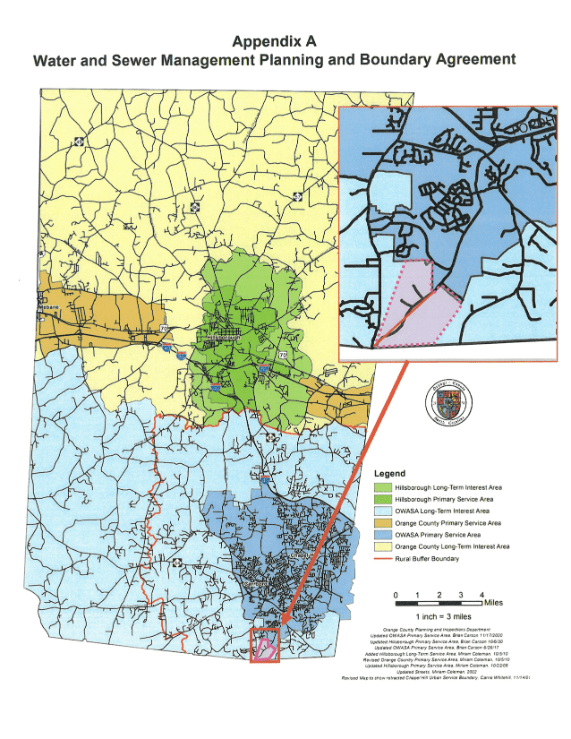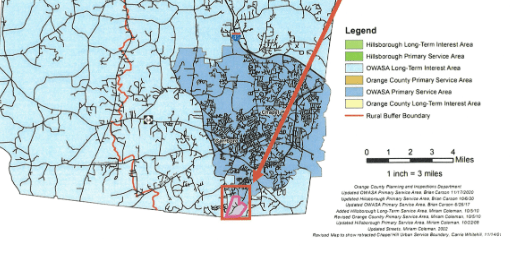Tomorrow night, the Chapel Hill Town Council will decide whether to expand the water and sewage boundary along the 15-501 corridor to the Chatham County line. This is a BFD, and we’ll explain why in a second.

But first, some terminology.
- The service area of our water and sewer services is called the urban services boundary. The Urban Services Area includes not only Chapel Hill and Carrboro, but also several “transition areas.”
- The rural buffer is an area zoned to keep development intensity low.
- The extra-territorial jurisdiction (ETJ) is where Chapel Hill (and Carrboro) have planning jurisdiction outside of the town limits.
- OWASA stands for the Orange Water and Sewage Authority. That’s the utility that provides our water and sewage service.
- WASPMBA stands for the Water and Sewage Management, Planning and Boundary Agreement. Chapel Hill, Carrboro, Hillsborough, Orange County, and OWASA are all parties to this agreement. It has been updated over the years.
Now that we’ve got our vocabulary down, let’s examine what’s on the table.
- In June, Council received a petition asking to “evaluate a limited extension of the current water and sewage boundaries by extending the 2001 boundary one mile south of the current line.”
- Right now, the boundary extends to the tip of the Southern Village dog park. Some residents south of the dog park are hooked up to water and sewage; others currently have septic tanks and well water. Thousands of workers commute to UNC from Chatham County, which is just beyond the proposed service area.
- The petition notes “expanding the OWASA service area will enable the development of multifamily housing, bring housing more proximate to employment centers, and creat[e] the population density needed to support transit and reduce commuter traffic.”
- The proposal does not encompass a “physical extension of water or sewage services.” Rather, it would allow for future OWASA service in those areas, should they be developed in future decades.
What’s good about this plan
The Planning Department’s staff report highlights how the plan aligns with the Complete Community strategy. What jumped out at us is as follows:
- The requested extended area is along the planned route for the North-South Bus Rapid Transit line that commuters will take to UNC. This is in line with the Complete Communities strategy.
- The Town of Chapel Hill owns 12 acres that would be served by this extension and could provide affordable housing. (It’s much cheaper for the town to build affordable housing on land it owns.)
- Sewer systems have lower risk of groundwater contamination than septic tanks.
- This is a way to plan for missing middle housing – duplexes, townhouses, triplexes – for UNC and UNC Health employees in the coming decades.
In addition, we would like to highlight the following:
- When the rural buffer was created, Southern Village didn’t exist and there was very little development along what is now a divided highway that runs all the way to Pittsboro. Even so, this land was left in the ETJ because it made sense to build housing along transportation corridors. Now large neighborhoods like Briar Chapel and mega-projects like Chatham Park mean that thousands of people drive into Chapel Hill from Chatham County every day. The “leapfrog development” that’s happening now is terrible for the environment, and extending the water and sewer service boundary along a busy highway will make it easier for people to live in southern Orange County instead of further away. (For more on this, see our piece on the rural buffer from 2022).
- If we could wave a magic wand, we envision that this extension could potentially create another Southern Village in 30 or 40 years: a mixed-use neighborhood that’s walkable, contains a variety of housing types, and located on the BRT line. This is the kind of development that Chapel Hill should be planning towards, to lessen driving, to create more housing types for people at different stages of their lives, and to plan along the BRT route.
- The town has submitted a grant proposal for construction of a multi-use path from the Southern Community Park all the way to the Chatham County line. We think that the town should mandate that any future developers build a greenway across pieces that are on their parcels. (See: Cary, which adopted this strategy and has almost 80 miles of greenways.) Right now, it’s less than two miles – a 10-minute bike ride – from the Southern Community Dog Park to Walmart. Every person living between the two should be able to easily get to the Southern Village park-and-ride lot and the BRT without getting in a car.
Opponents to the extension – CHALT, namely – are calling for an environmental analysis and a small area plan. These are stall tactics. Any development occurring in the coming decades would, of course, be subject to rigorous environmental and stormwater requirements and would have to follow them. What an environmental analysis wouldn’t include is this: the impact of continuing to have tens of thousands of commuters drive in from Chatham County and beyond. Adding housing of all types along the planned BRT line over the coming decades will ensure that the future of Chapel Hill land use is more environmentally friendly than its past.

